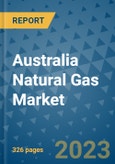Market Insights
Australia remains a vital player in the global natural gas Analysis, particularly due to its leading position in liquefied natural gas (LNG) exports. With LNG being a cleaner energy alternative to coal, demand from Asian countries such as China, Japan, and South Korea continues to support Australia’s export-driven gas economy. However, the nation also faces challenges domestically, including gas shortages and pressure to align with climate change goals.Despite this, the government views natural gas as a transitional energy source, bridging the gap between fossil fuels and renewable energy adoption. The natural gas sector contributes significantly to the residential, industrial, and power generation sectors, underlining its importance in Australia’s overall energy mix.
Drivers
A key factor propelling market growth is the increasing use of natural gas as an alternative fuel. It offers a lower environmental footprint compared to coal and oil, making it more attractive for industrial operations, power generation, and transportation. Australia’s well-established gas distribution infrastructure further eases accessibility and distribution.The transportation sector, in particular, is experiencing a rise in the use of compressed natural gas (CNG) and liquefied natural gas (LNG) vehicles. Fleet operators are turning to natural gas due to its cost-efficiency, cleaner emissions, and widespread availability.
Another vital growth driver is Australia’s significant role as a global LNG exporter. With vast reserves and an advanced export infrastructure, the country supplies major Asian economies with LNG, strengthening its trade balance and international standing.
Business Opportunity
The market presents notable opportunities, especially with the emergence of smaller, innovative players. These entrants, often focused on modular LNG plants and unconventional gas sources, bring agility and new technology to the sector. Their ability to tap into coal seam gas and shale reserves adds to Australia’s energy diversity and supply security.Investment in technology and infrastructure - such as pipelines, storage, and liquefaction plants - is also expected to increase. Global energy companies like Chevron and POSCO INTERNATIONAL are actively expanding their LNG capacities in Australia, which will support market development and employment generation.
Moreover, integrating natural gas with renewable energy sources like biogas and hydrogen presents an avenue for a cleaner, hybrid gas network, aligning with global sustainability goals.
Region Analysis
Victoria emerges as a key regional contributor, accounting for a significant share of Australia’s natural gas production. The state's proximity to major demand centers like Melbourne and Sydney, combined with its access to the long-standing Bass Strait fields, strengthens its market position.Victoria also benefits from a developed pipeline network and supportive government policies that attract technological investment. Other leading regions include Western Australia, Queensland, and South Australia, each contributing actively to national output and export capacities.
Key Players
The market features a moderately consolidated Analysis, with leading producers accounting for 65% to 70% of total market share. Prominent companies include:
- Chevron
- Shell
- ExxonMobil
- BP
- POSCO INTERNATIONAL
- China National Petroleum Corporation
- Total S.A.
- Gazprom
- ConocoPhillips
- Eni S.p.A.
Recent Developments:
- In June 2024, POSCO INTERNATIONAL invested AUD 300 billion into its subsidiary Senex Energy, aiming to triple gas production by 2026.
- Chevron resumed full operations at its Wheatstone facility, strengthening LNG exports to Japan and South Korea.
- Shell’s acquisition of Nature Energy solidified its leadership in renewable natural gas.
Challenges
Australia’s path toward net-zero emissions poses a challenge for the natural gas sector. While gas is cleaner than coal, it still emits greenhouse gases, prompting concerns from environmental groups. Additionally, the imbalance between domestic demand and export commitments can lead to local shortages and price volatility.Market Segmentation
By Type:
- Ethane
- Propane
- Methane
- Others
By Source:
- Conventional Gas
- Unconventional Gas
By Application:
- Automotive Fuel: LCVs, HCVs
- Power Generation
- Residential & Commercial: Heating, Cooking Gas, Appliances, Others
- Industrial Fuel: Mining & Metallurgy, Chemicals & Petrochemicals, Paper & Pulp, Food & Tobacco, Others
- Others
By Region:
- New South Wales
- Queensland
- South Australia
- Tasmania
- Victoria
- Western Australia
- Northern Territory
This product will be delivered within 1-3 business days.
Table of Contents
Companies Mentioned
- Gazprom
- Exxon Mobil Corporation
- China National Petroleum Corporation
- Royal Dutch Shell Plc
- BP Plc
- Chevron
- Total S.A.
- Statoil ASA
- Conoco Philips
- Eni.SpA
- EOG Resources
- Encana
- Cimarex Energy
- Exco Resources
- EQT
- Chesapeake Energy
- Hess Corp.
- SM Energy Company
- Anadarko Petroleum








